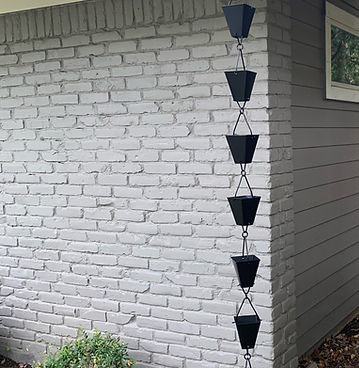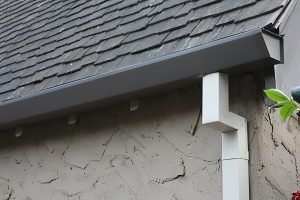Rain Chain vs Gutter Downspouts
When it comes to managing rainwater around your home, two of the most popular options are rain chains and downspouts. Both work in different ways, but with similar goals: to divert water away from your foundation and other parts of your home to prevent flooding and damage. Whether you’re looking for something eye-catching or want a more utilitarian approach, understanding the differences between rain chains and downspouts can help you choose the best solution for your needs.
Types of Rain Chains
The chain downspout has been around for centuries, tracing back to Japan and its use in Buddhist temples. Known as the kusari-doi, this ancient design functions much like its modern counterpart – it catches water from a gutter and channels it into decorative cups that run down to either a basin or the ground.
Gutter Adaptable Rain Chains
Gutter adaptable rain chains are designed to connect directly to an existing gutter system. These are perfect for homeowners who want an easy installation process and require little maintenance. The downside is that they only come in certain lengths, so if your roof or gutter line is too long, you may need to look elsewhere.
Traditional Rain Chains
Traditional rain chains are a bit more decorative than the gutter adaptable variety. They hang freely from the roof and catch water in discrete cups along their length. The beauty of traditional rain chains lies in their unique design, which comes in a wide variety of styles and materials.
Linked Rain Chains
Linked rain chains are very similar to traditional ones but with an additional component: metal links that fit into each other like puzzle pieces. The extra layer of detail creates a stunning effect when water passes between them. This type of rain chain requires slightly more maintenance than traditional ones, as any broken links must be replaced.
Copper Rain Chains
Copper rain chains are some of the most beautiful and durable varieties available. Their subtle patina lends a timeless charm to any outdoor setting, and thanks to its corrosion-resistant properties, copper will remain looking beautiful for many years. Copper rain chains tend to be more expensive than other types, but the investment is worth it for those looking for something truly special.
Rain chains offer an aesthetically pleasing alternative to traditional downspouts. They come in several different forms, such as cup styles and link chains, and can be made of materials ranging from copper to plastic. The main benefit of rain chains is that they’re much more attractive than plain old downspouts, adding visual appeal to any exterior design.
Advantages of Rain Chains
Rain chains offer a decorative element to your home that you can’t find with downspouts. Not only do they look beautiful, but they also create pleasant, natural sounds when the water runs down them. They’re also relatively easy to install and maintain. Furthermore, since they don’t require gutters, they can be especially attractive on homes without them.
- Low Maintenance: Rain chains offer a low-maintenance alternative to traditional gutters, as they require minimal cleaning and maintenance.
- Aesthetics: Rain chains can be used in a variety of styles and designs, allowing them to easily integrate into the overall look of your home or garden.
- Durability: Made from materials like copper, aluminum, or stainless steel, rain chains are designed to stand up to harsh weather conditions.
- Eco-Friendly: Rain chains provide an eco-friendly way to collect rainwater, reducing runoff and helping conserve water.
- Cost-Effective: Rain chains are one of the most cost-effective ways to collect and manage rainwater.
Disadvantages of Rain Chains
The main drawback with rain chains is that because they don’t channel the water into a drain or away from the home, they can lead to flooding and property damage if there isn’t a proper drainage system. This can be especially problematic during heavy rains.
Rain chains are a popular modern alternative to traditional downspouts, but they do have their drawbacks. Here are some potential disadvantages to consider before installing rain chains in your home:
- Noise: Rain chains can create an unwelcome noise when it rains, particularly if the water is dropping from a great height or hitting a metal chain.
- Clogging: Leaves and other debris can become lodged in a chain’s links and cause it to clog. This can disrupt the flow of water and cause overflowing.
- Maintenance: The chains need to be regularly inspected for holes, rust, and clogs, which requires climbing on a ladder for cleaning or repair.
- Cost: Rain chains tend to be more expensive than traditional downspouts.
- Inadequate Drainage: The amount of water that a rain chain can handle is limited compared to traditional downspouts, which can affect drainage capacity during heavy rains.
Do rain chains work as well as downspouts?
Rain chains may seem like an appealing alternative to conventional downspouts, but they ultimately lack the same efficiency and utility. In areas with heavy rainfall, rain chains are not a suitable replacement for traditional gutter systems; in these cases, it would be more effective to rely on a combination of both options. Rain chains may be able to handle some of the stormwater, particularly from lighter showers, but downspouts are still essential for capturing the majority of rainfall and directing it away from your home.
Advantages of Downspouts
Downspouts are the traditional solution for controlling rainwater runoff. They tend to be more effective at directing the water away from the home, reducing the risk of flooding or other damage. They’re also quite easy to install and maintain and can be painted to match your home.
- Enhanced Structural Integrity: Downspouts are designed to distribute the flow of water away from the foundation of a structure, aiding in the prevention of deterioration and erosion.
- Improved Aesthetics: Downspouts make a home look more aesthetically pleasing by providing a visual accent and directing water away from the house and into more appropriate drainage areas.
- Better Drainage: Downspouts help channel rainwater away from structures, preventing pooling near foundations. This helps reduce the risk of flooding, water damage, and mold growth in the vicinity.
- Reduced Maintenance Needs: By properly redirecting the flow of water away from an area with downspouts, homeowners can save time and effort in terms of maintenance needs like repainting and other repairs.
Disadvantages of Downspouts
Downspouts can detract from the aesthetic appeal of a home or garden. They can be quite bulky and clunky looking, and depending on their color may clash with the design of the house or landscape. In contrast, rain chains provide a sleek and stylish look that adds beauty to any outdoor space. They come in many different styles and are made out of materials such as copper, aluminum, and stainless steel, allowing for greater flexibility in design.
When choosing a downspout, homeowners have limited options in terms of color variety. Downspouts usually come in one color – white – and though they can be painted any color you like, this can be time-consuming and labor-intensive. With rain chains, homeowners have the option of choosing from a wide array of vibrant colors and styles to match any outdoor décor.
Which Option Is Right for You?
When it comes to deciding between rain chains and downspouts, it all depends on your personal preferences and what you need from this system.
When it comes to dealing with downpours and the subsequent runoff, traditional gutter downspouts provide an effective solution. They are highly durable and able to withstand even heavy rain with ease, quickly diverting precipitation away from your home and foundation. Additionally, their design prevents the accumulation of stagnant water, helping to reduce the risk of pest infestations as well as soil erosion. In comparison, rain chains offer fewer benefits in terms of performance and may leave puddles near your home’s foundation that could cause problems. Therefore, traditional gutter downspouts are often a more reliable option for most homeowners’ needs.
If you’re mostly concerned with function over aesthetics, a downspout might be the better choice. But if you’d prefer something more eye-catching that compliments your home decor, then rain chains could be the right fit. Ultimately, the choice is yours!


